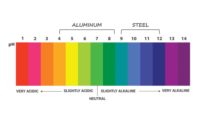The reactive metals by classification are zirconium, titanium and beryllium. We also include here tantalum and columbium (niobium), being from the refractory class and which also present similar challenges to the welding engineer.
Aerospace, automotive, medical and military industries are increasingly using all these materials. They have many technological attractions being durable, low density, bio-compatible and offering high corrosion resistance but they are expensive. Welding procedures need to be carefully developed and stringently applied to avoid expensive waste, rework or risk of service failure.
Successful fusion joining techniques have evolved1 since the alloys were first used in engineering applications. The majority of metallurgical problems, even considering dissimilar metal welding, have been resolved and filler materials are readily available. However, their reactive nature make it essential to continue to address the requirement for thorough pre-cleaning and particularly oxidation at the high temperatures involved in arc welding.
Title: White Paper 307: Welding Reactive Metals
Website: www.huntingdonfusion.com
Format: PDF
Link: Welding Reactive Metals White Paper




